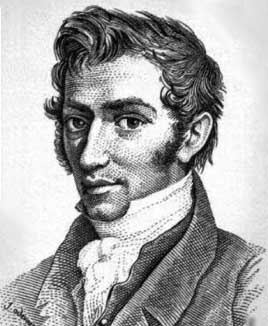| Profile | Major Works | Resources |
Lambert Adolphe Jacques Quetelet, 1796-1874.

Belgian mathematician, astronomer and founding father of modern statistics.
Born to family of Picardie immigrants and raised in French-occupied Ghent, Adolphe Quetelet attended a French lycee in that city. After his father's death, the young Quetelet began working as a mathematics tutor to bring in some extra francs. In 1815, he was appointed as instructor in mathematics at a new collège set up by the Dutch royal government. He proceeded to write a doctoral dissertation under J.G. Garnier at the newly-founded Dutch state university at Ghent. He subsequently took up an appointment at the Athenaeum in Brussels. Bursting with ambition, the young Quetelet was elected to the Belgian Academy and submitted proposals to the government for the construction of an observatory in Brussels. To that end, in 1823, he spent a sojourn at the Paris Observatory under Bouvard to acquire the necessary knowledge. It was here that he learnt the method of least squares and the Laplacian theories of mathematical probability, then used in French astronomy. He returned to Belgium, ready for the observatory (built 1828) and, more importantly, bubbling with enthusiasm for the new mathematical statistics. Quetelet believed could be used as a unifying method, not only for astronomy, but for all sciences dependent on observation, including meteorology, biology and the social sciences. His early statistical memoirs include attempts was on periodic curve-fitting on birth and mortality tables. He also began lecturing on probability theory, both at the Athenaeum and to the general public at the Brussels Museum (these lectures would be published in 1828).
The 1830 revolution which restored Belgian independence nearly toppled Quetelet, who was perceived as too close to the Dutch government. But Quetelet weathered the storm. Indeed, it was in its immediate aftermath that he began producing some of his most revolutionary work. The big impetus in this was his analysis of crime. While the regularity of natural human phenomena, such as birth and mortality rates, was already well-known and ascribed as part of divine providence, the regularity of crime, being essentially a matter of human choice, was more surprising and repulsive to the prevailing thinking of the age. An individual either commits a crime or he doesn't. It is a free and moral decision, not a probability. To suggest that a certain regular and predictable amount of crime happens in society yearly shifts the concern away from the concrete individual case to the aggregate, the "state of society". Public policy and social reform, consequently, should not pin its hope on moral reform or punishment of particular individuals, but to address the aggregate, change the social configuration or general customs, if it hopes to make a dent on such phenomena.
To this end, Quetelet introduced the device of the "average man" (l'homme moyen), the 'representative agent' of a society, measurable not only in terms of average physical characteristics (height, weight, etc.) but also measurable "moral" characteristics ("penchants" for crime, suicide, courage, etc., to be proxied by statistics). This man, of course, does not exist. But it is a useful fiction by which to examine "differences" in societies over space and time and the success or failure of policy reforms. Actual man is distributed as a "normal curve"
Quetelet's analysis, while obvious in our day, helped revolutionize thinking in Europe. Public policy and social reform was to be refocused on aggregate measures within aggregate constraints and assessed by quantifiable results. Social science was also revolutionized, one can say indeed "created" for the first time as a 'science' proper, as free individuals of wholly autonomous and capricious character were reduced to deviation errors from the homme moyen. Society, it turns out, was governed by statistical laws, which can be discovered and quantified. The "progress of civilization" is no longer a matter of conjectural history by stages and by analogy, but concretely and continuously measurable. Indeed, we can go so far as to say that Quetelet proved "society" exists, with particular characteristics and laws of its own, and not merely as shorthand for an aggregation of persons.
In 1832, William Whewell invited Quetelet to present his results at a celebrated Cambridge meeting of the British Association for the Advancement of Science. It was a tremendous success, which helped lead to the foundation of "Section F" of the BAAS in 1833 and the Statistical Society of London in 1834.
Quetelet's1835 Sur l'homme et le développement de ses facultés presented his ideas to a wider public and was an international hit.
While not a Saint-Simonian himself, Quetelet's breakthrough seemed to confirm, or at least give quantifiable teeth, to the driving concept behind that movement (Quetelet absconded with their phrase, physique sociale, to describe his own work). It also seemed to chime with the work of Quetelet's contemporary, August Comte, even though the latter disparaged Quetelet's work as "mere data" with no implications on his own schema.
|
Major Works of Adolphe Quetelet
|
|
HET
|
|
Resources on Adolphe Quetelet
|
All rights reserved, Gonçalo L. Fonseca
